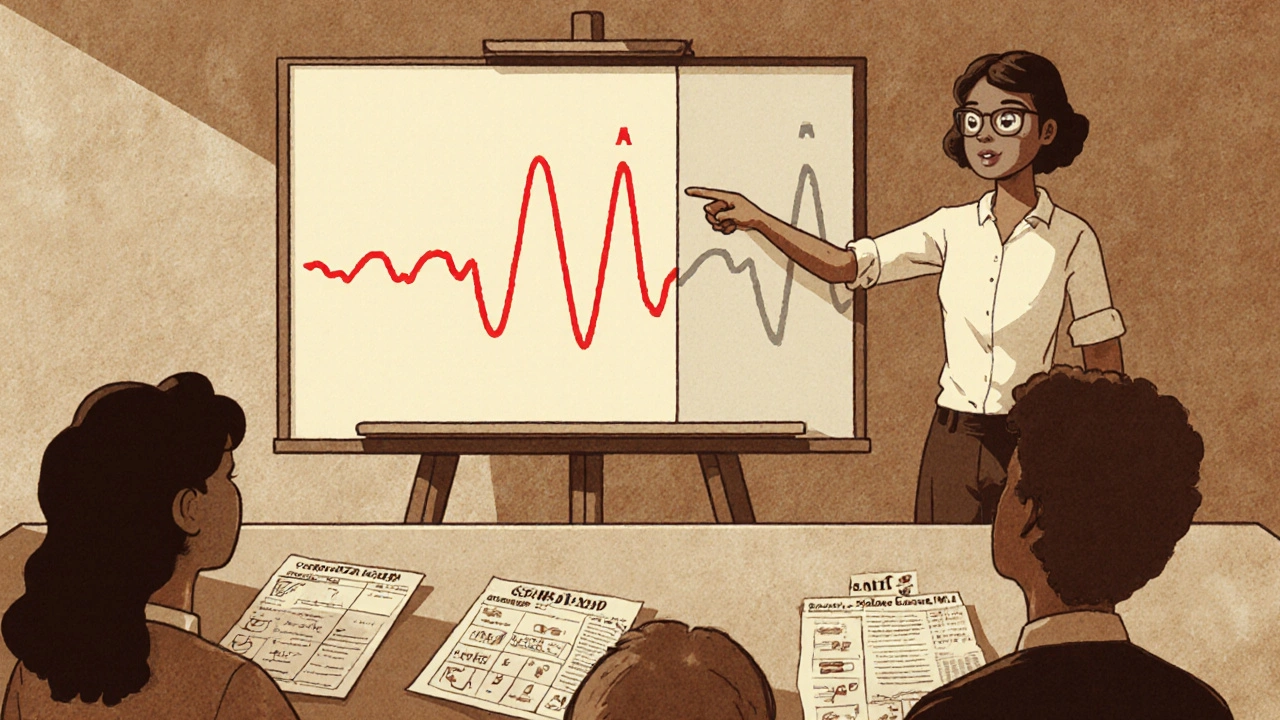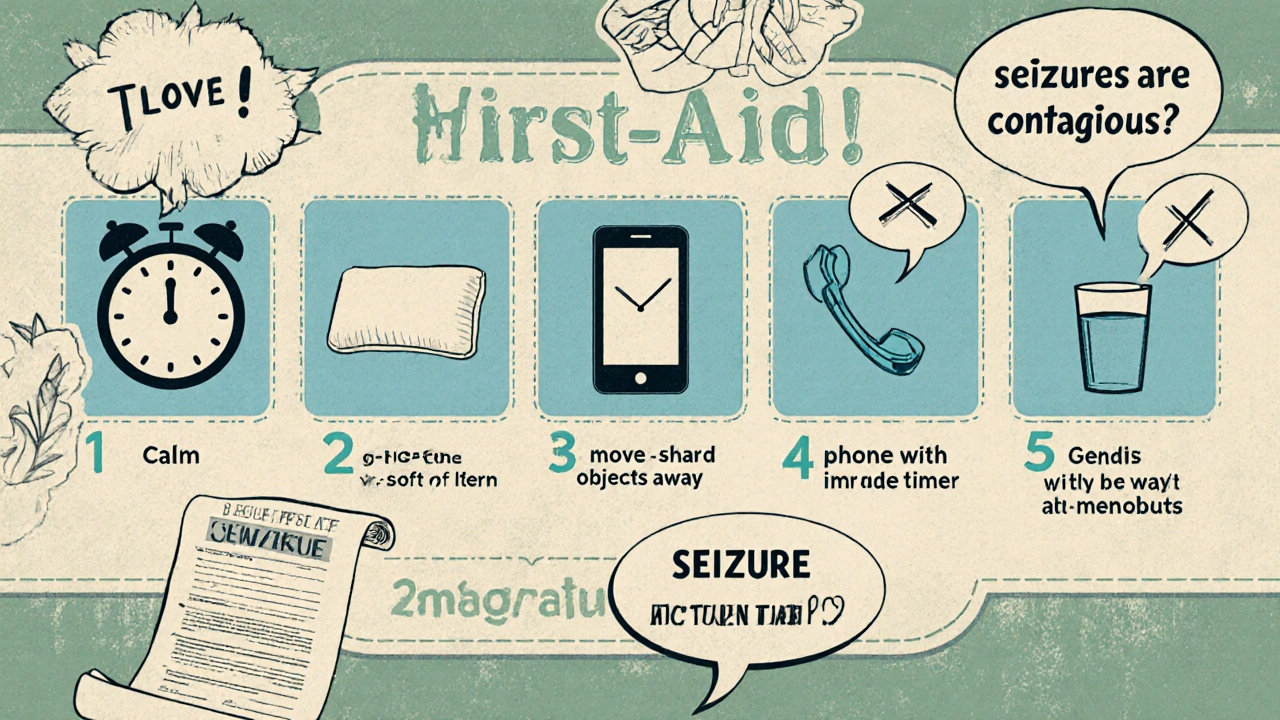Educating Others About Partial Onset Seizures: A Step‑by‑Step Guide
Key Takeaways
- Partial onset seizures start in a specific brain region and can be subtle.
- Simple, accurate language and visual aids make education effective.
- Focus on what to do during a seizure, not just what it looks like.
- Address myths early to prevent stigma.
- Provide handouts, action plans, and follow‑up resources for lasting impact.
What are Partial Onset Seizures?
When talking about Partial Onset Seizure is a type of seizure that begins in a localized area of the brain and may stay confined (simple focal) or spread to affect consciousness (complex focal), it helps to picture the brain as a city. One neighborhood lights up, causing flickers in the whole system only if the spark spreads.
These seizures are also called focal seizures. They can cause sensations like tingling, visual distortions, or a brief feeling of déjà vu called an Aura. Recognizing an aura can give the person a heads‑up before the event escalates.
Why Educating Others Matters
Many people still think seizures are always dramatic convulsions. That myth leads to panic, discrimination, and unsafe reactions. By giving friends, coworkers, and family the right facts, you create a supportive environment where the person with epilepsy feels safe and understood.
Effective education also reduces emergency calls for non‑life‑threatening events, which frees up medical resources for true crises.
Step 1: Know the Basics
Before you can teach, you need a solid foundation:
- Partial vs. Generalized: Partial seizures start in one brain region; generalized seizures involve both hemispheres from the start.
- Types of focal seizures:
- Simple focal - awareness remains; symptoms might be a brief twitch or a strange taste.
- Complex focal - consciousness is altered; the person may stare blankly or perform automatisms (repetitive movements).
- Common regions: Temporal lobe seizures often produce auras; frontal lobe seizures can cause sudden jerks.
Use an EEG (electroencephalogram) as a visual reference. Show a real‑world waveform and point out the focal spikes that differentiate partial seizures from the diffuse spikes of generalized seizures.

Step 2: Gather Reliable Resources
Stick to reputable sources like the Epilepsy Foundation, the American Epilepsy Society, and peer‑reviewed neurology journals. Download fact sheets that are free of jargon and have clear graphics.
When you cite a source, note the year (e.g., "2023 Epilepsy Foundation guidelines") so learners see that the information is current.
Step 3: Create Simple Explanations
Break down technical terms into everyday language. For example, describe an aura as "the brain's "warning light" that flashes before a seizure." Use analogies: a city power outage starts in one block before the whole grid goes dark.
Write a one‑paragraph blurb you can read aloud in 30 seconds. That becomes your elevator pitch:
"A partial onset seizure begins in a small part of the brain. It might feel like a brief buzz, a weird smell, or a sudden twitch. Most of the time it stops on its own, but knowing the warning signs helps keep everyone safe."
Step 4: Use Visual Aids & Demonstrations
People remember pictures better than words. Create a simple chart comparing partial and generalized seizures. Below is a ready‑to‑print table you can hand out.
| Feature | Partial (Focal) | Generalized |
|---|---|---|
| Onset | Localized brain area | Both hemispheres simultaneously |
| Awareness | Often preserved (simple) or altered (complex) | Usually lost |
| Typical symptoms | Tingling, aura, brief jerks | Full‑body convulsions, loss of consciousness |
| EEG pattern | Focal spikes | Generalized spikes |
| First‑aid focus | Stay calm, protect head, time the event | Same plus ensure airway |
Print the table on cardstock so it doesn’t tear during a workshop.
Step 5: Teach First‑Aid and Safety Measures
Most partial seizures end within a minute, but the person may be confused afterward. Your teaching checklist should include:
- Stay calm and note the start time.
- Move sharp objects away; do not restrain the person.
- Place something soft under the head.
- If the seizure lasts more than 5 minutes, call emergency services.
- After the event, speak in a gentle tone, reassure, and offer a glass of water.
Introduce the term Seizure Action Plan. Show an example filled‑out form that lists the person's medications, known triggers, and emergency contacts.

Step 6: Address Myths and Stigma Directly
Common misconceptions include:
- "Seizures are always dangerous." - Most focal seizures are brief and non‑injurious.
- "People with epilepsy can’t drive." - With proper control and doctor clearance, driving is allowed in most states.
- "Seizures are contagious." - Absolutely not; they’re a brain event.
Debunk each myth with a short fact and a source citation. Encourage the audience to ask questions; the more they talk, the more confidence they gain.
Step 7: Provide Ongoing Support
Learning doesn’t stop after a single session. Offer:
- Printed handouts with local support groups (e.g., Austin Epilepsy Society).
- Links to online webinars from the Epilepsy Foundation.
- A follow‑up email that includes a Neurologist contact list for any medical questions.
When people know where to turn for extra help, they’re more likely to retain and apply what they learned.
Quick Reference Checklist for Educators
- Define partial onset seizures in plain language.
- Show a visual of an EEG focal spike.
- Hand out the comparison table.
- Demonstrate first‑aid steps with a volunteer.
- Address at least three common myths.
- Leave a printed Seizure Action Plan template.
- Provide contact info for local support groups and a neurologist.
Frequently Asked Questions
How long do partial onset seizures usually last?
Most simple focal seizures end within 30 seconds to 2 minutes. Complex focal seizures may last up to 3 minutes, but any seizure lasting longer than 5 minutes requires emergency care.
Can a person with partial seizures drive?
Yes, if a doctor has confirmed the seizures are well‑controlled and there have been no recent episodes while driving. Most states require a medical review and sometimes a driving test.
What are common triggers for focal seizures?
Triggers vary, but common ones include sleep deprivation, flashing lights, stress, alcohol, and certain medications. Keeping a seizure diary helps pinpoint personal triggers.
Do antiepileptic drugs stop partial seizures completely?
Many people achieve full control, but some may still have occasional auras. Adjusting dosage or switching to a newer Antiepileptic Drug under a neurologist’s guidance can improve outcomes.
How can I help someone who is having a seizure?
Follow the five‑step first‑aid list: stay calm, protect the head, clear the area, time the seizure, and call emergency services if it exceeds 5 minutes or the person is injured.







9 Comments
alex montana
October 18, 2025 at 17:06
Wow... another guide about partial seizures??? It's like they think the world needs yet another checklist, and we're just supposed to drink it all up like it's medicine!!! But really, who has time for all those tables and fancy EEG pictures??!
Grace Hada
October 19, 2025 at 20:53
Stop sugar‑coating seizures – they're not a hobby.
Fabian Märkl
October 21, 2025 at 00:40
Hey everyone! 🙌 This guide nails the basics – clear, punchy, and totally usable in a workshop. The visual table is gold, and the step‑by‑step first‑aid list makes it easy to remember. Keep spreading the word! 🚀
Avril Harrison
October 22, 2025 at 04:26
Honestly, this is pretty solid. Loved the city analogy – makes the whole thing click without sounding like a textbook. Might just hand out those handouts at the next community meet.
Natala Storczyk
October 23, 2025 at 08:13
FORGET EVERYTHING YOU THOUGHT YOU KNEW ABOUT EPILEPSY!!! This guide SLAMS the myths into oblivion!!! The myth‑busting section is a BATTLE‑CRY for anyone tired of the stigma!!!
nitish sharma
October 24, 2025 at 12:00
Dear colleagues, I commend the author for assembling a comprehensive step‑by‑step manual on educating laypersons about partial onset seizures. The document begins with a succinct enumeration of key takeaways, thereby setting clear expectations for the reader. By distinguishing partial from generalized seizures early on, it mitigates the prevalent misconception that all seizures are convulsive. The inclusion of visual aids, such as the comparative EEG chart and printable tables, aligns with adult learning principles that emphasize multimodal instruction. Moreover, the recommended use of plain language, exemplified by the “warning light” analogy for auras, enhances accessibility for non‑medical audiences. The checklist of first‑aid actions is thorough yet concise, covering the essential steps without overwhelming the learner. I appreciate the emphasis on myth‑busting, as addressing stigma is crucial for fostering inclusive environments. The provision of actionable resources, including handouts, support‑group listings, and neurologist contact information, ensures continuity of learning beyond the initial session. Additionally, the guide’s suggestion to incorporate a seizure action plan template reflects best practices in chronic disease management. The phased structure-from foundational knowledge to practical demonstration-mirrors effective curriculum design. It is noteworthy that the author advises the use of reputable sources such as the Epilepsy Foundation, thereby reinforcing the credibility of the material. The recommendation to cite publication years further underscores the importance of up‑to‑date information. From an educational perspective, the guide successfully balances depth with brevity, making it suitable for both community volunteers and healthcare professionals. I would suggest adding a brief segment on cultural considerations, as attitudes toward epilepsy can vary significantly across different populations. Finally, the overall tone is supportive and empowering, which is essential for motivating participants to act confidently in emergency situations. In summary, this guide stands as an exemplary resource for anyone tasked with disseminating knowledge about partial onset seizures.
Rohit Sridhar
October 25, 2025 at 01:53
Thanks for the detailed rundown, nitish! I love how you highlighted the action plan – it really ties everything together. Adding a cultural note is a brilliant idea; it’ll make the sessions resonate even more.
Sarah Hanson
October 25, 2025 at 15:46
Natala, your enthusiasm is appreciated, however the over‑use of exclamation marks may distract from the core message. Let’s keep it professional while still engaging the audience.
Nhasala Joshi
October 26, 2025 at 18:33
🔬🚨 Beware the covert neuro‑cascades! The clandestine propagation of focal discharges often evades lay detection, yet the systemic ramifications can be profound. Trust the data, question the narrative, and stay vigilant. 🧠💥